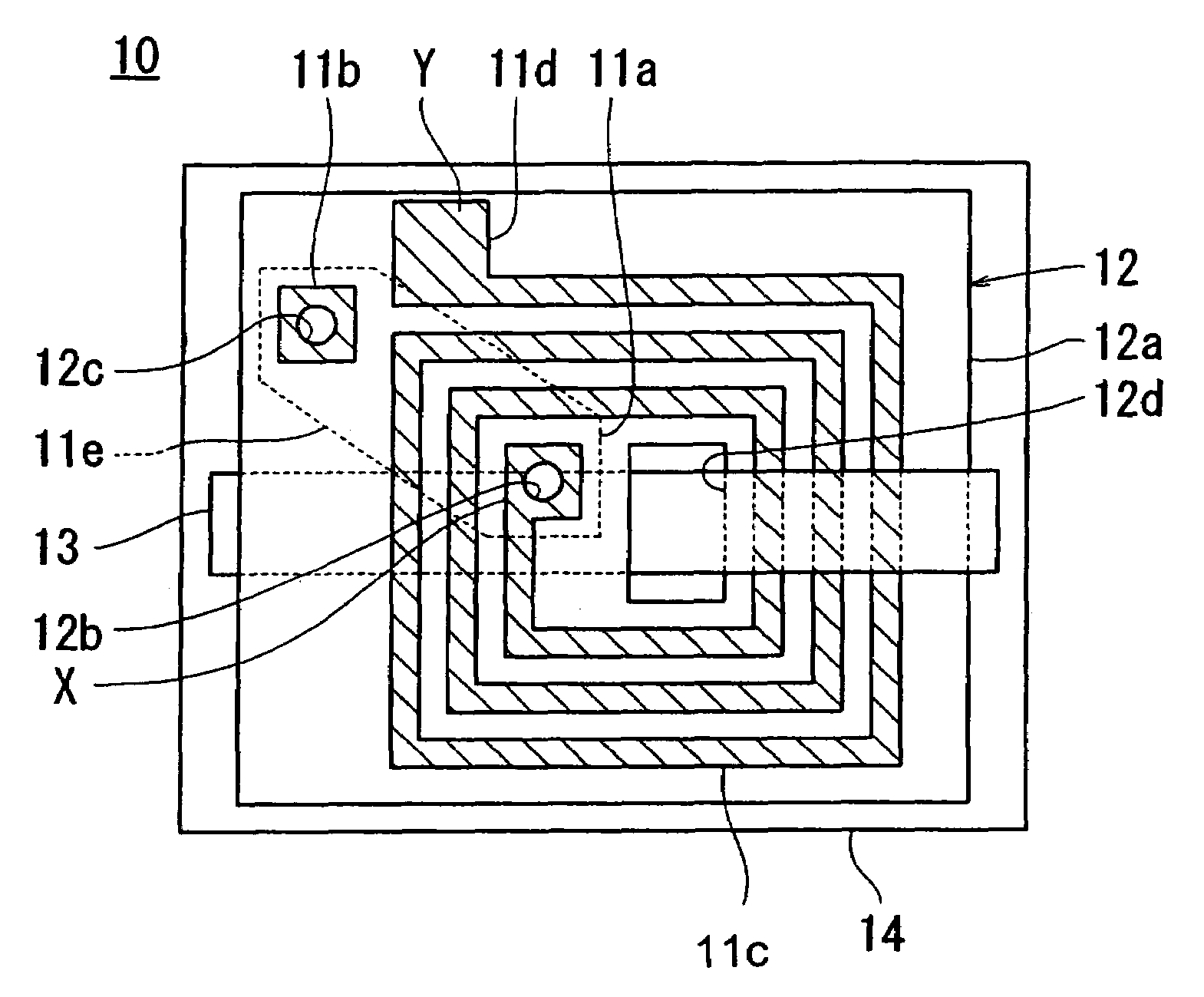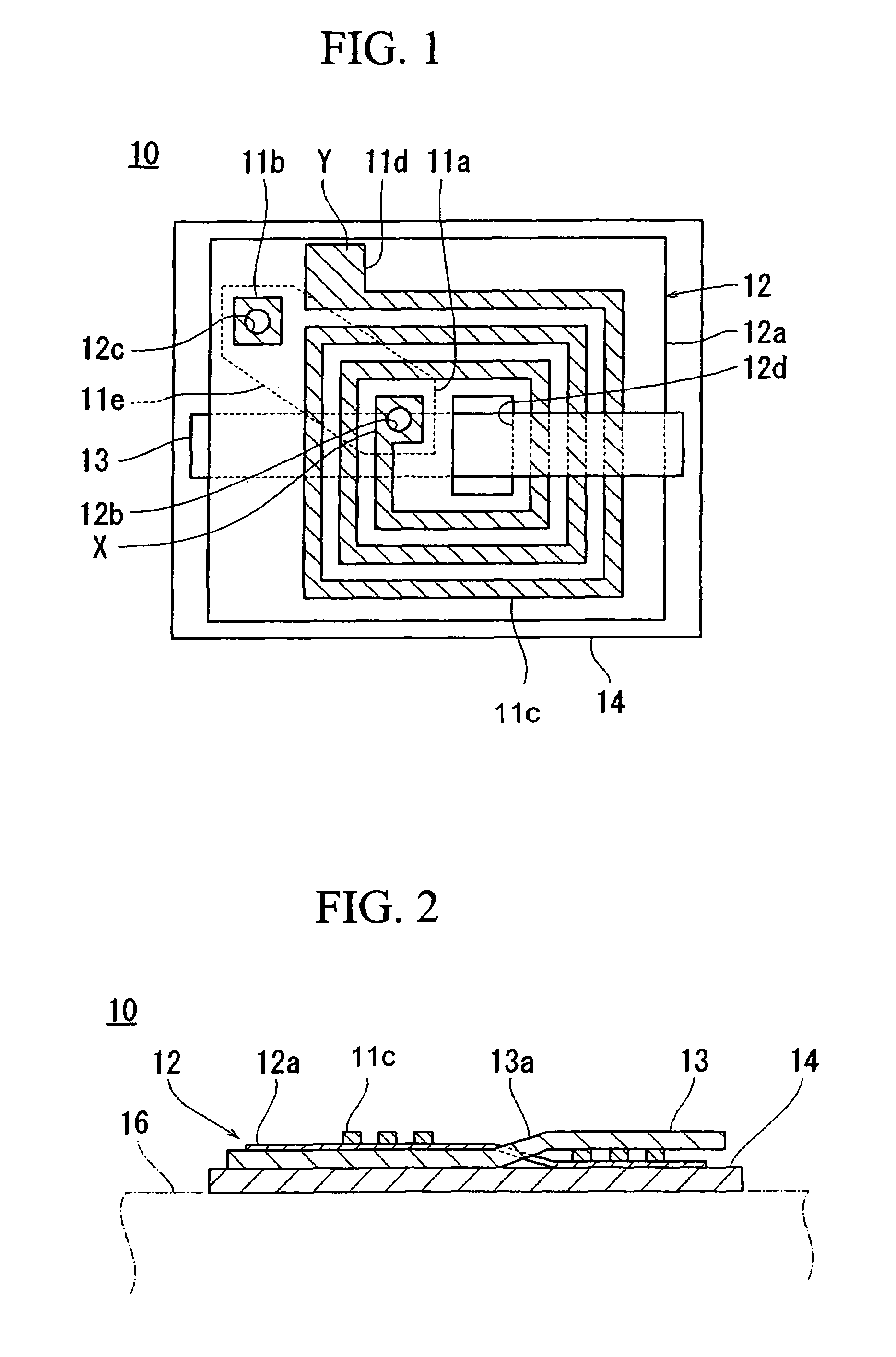Antenna coil, and RFID-use tag using it, transponder-use antenna
a technology of rfid-use tag and antenna coil, which is applied in the direction of loop antennas with ferromagnetic cores, resonant antennas, instruments, etc., can solve the problems of excessive protruding antenna coils from articles, decreased q value, and inability to use, etc., to achieve high rigidity
- Summary
- Abstract
- Description
- Claims
- Application Information
AI Technical Summary
Benefits of technology
Problems solved by technology
Method used
Image
Examples
example 1
[0123]First, an air-core coil is formed on a main surface of an electrically insulating film. For the electrically insulating film, a polyimide film having 50 mm longitude and 50 mm latitude and 50 μm thickness is used. A copper film having 35 μm thickness is layered to be bonded on a main surface of the polyimide film so as to etch the copper film. By doing this, an air-core coil which is wound helically in a four-time rectangular manner is formed on a main surface of the polyimide film. The conductive member which forms the air-core coil is formed so as to have 0.8 mm width. An outer shape of the air-core coil is formed so as to have a dimension such as 18 mm×47 mm.
[0124]Next, a mixture of 92 weight % of a carbonyl iron powder and a nylon resin is injected into a mold. By doing this, a magnetic core member 13 which is formed by a composite member having 0.87 mm thickness and 35 mm×52 mm dimension is obtained. Consequently, a hole having 35 mm×1 mm of dimension is formed on an elec...
example 2
[0125]An air-core coil which is the same as that of the example 1 is formed on an electrically insulating film which is the same as the electrically insulating film of the example 1 by the same conductive member as that of the example 1 by the process which is the same as the process in the example 1. Also, a paint is prepared in which 70 weight % of amorphous flake, 10 weight % of acrylic resin, and 20 weight % of ethyl acetate as a solvent are mixed. The paint is applied and dried on an entire main surface of a film which is formed by a polyethylene terephthalate having 0.1 mm thickness. Thus, a magnetic coating having 0.1 mm thickness is obtained. A film on entire main surface of which the magnetic coating is formed is cut in to a dimension of 35 mm×60 mm with the magnetic coating. Thus, the magnetic core member 13 which is made of a magnetic coating which is formed by applying and drying the composite member is obtained. Consequently, a hole having 35 mm×1 mm of dimension is for...
example 3
[0153]As shown in FIGS. 4 and 5, a conductive member 112 is formed on a surface of the electrically insulating member 111 which is formed by an electrically insulating film. For the electrically insulating film, a polyimide film is used which has a dimension such as 50 μm thickness, and longitude and a latitude such as 65 mm×55 mm. A copper film having 35 μm is layered and bonded on a main surface of the polyimide film. A continuous conductive member 112a is formed on a surface of the polyimide film by etching the copper film such that the conductive member 112 has three winding forwarding sections 112a and three winding returning sections 112b both of which has 40 mm length are formed on a surface of the polyimide film alternatively with an interval of 10 mm. The conductive member 112 has 0.8 mm width.
[0154]After that, the first magnetic core member 113 having a dimension such as 1 mm thickness and longitude and a latitude such as 40 mm×20 mm is bonded on a back surface of the cond...
PUM
 Login to View More
Login to View More Abstract
Description
Claims
Application Information
 Login to View More
Login to View More - R&D
- Intellectual Property
- Life Sciences
- Materials
- Tech Scout
- Unparalleled Data Quality
- Higher Quality Content
- 60% Fewer Hallucinations
Browse by: Latest US Patents, China's latest patents, Technical Efficacy Thesaurus, Application Domain, Technology Topic, Popular Technical Reports.
© 2025 PatSnap. All rights reserved.Legal|Privacy policy|Modern Slavery Act Transparency Statement|Sitemap|About US| Contact US: help@patsnap.com



